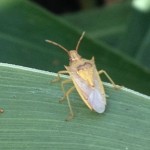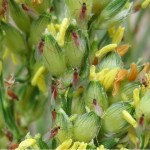Fields of grain sorghum in Calhoun, Refugio and Victoria Counties range from 6-7 leaf to mid-late bloom. The most important insects we are seeing are sorghum midge and aphids.
Sorghum midge are only pests of grain sorghum during bloom. The adult sorghum midge is a 1.3-mm-long, fragile-looking, orange-red fly, with a yellow head, brown antennae and legs, and gray membranous wings. (Source)
During the single day of adult life, each female lays about 50 yellowish-white eggs between the glumes of flowering spikelets of sorghum. Larvae complete development in nine to eleven days and pupate between the glumes of the spikelet.
Sorghum midge larvae feed on the newly-fertilized ovary, preventing kernel development and causing direct grain loss. Glumes of a sorghum midge-infested spikelet fit tightly together because no kernel develops. Typically, a sorghum panicle infested by sorghum midge will have, depending on the degree of damage, various proportions of normal kernels scattered among non kernel-bearing spikelets.
Abundance of sorghum midge adults must be assessed. To do so, fields should be inspected at mid-morning when the temperature reaches approximately 80° F, when sorghum midge adults are most abundant on flowering sorghum panicles. Because adult sorghum midge live less than one day, a new brood is present each day. Sorghum midge abundance should be monitored almost daily during panicle flowering. Sorghum midge adults crawl on or fly about flowering panicles. The easiest and most efficient way to detect and count sorghum midge is carefully inspecting of all sides of randomly-selected flowering panicles. Panicles should be handled carefully to avoid disturbing ovipositing sorghum midges. Other methods, such as placing a clear plastic bag or jar over the panicle as a trapping device, can be used.
Other insect pests to check in headed sorghum include stink bugs and headworms. Check for stink bugs and headworms using a bucket to beat the heads into. By checking 10-20 heads at 5-10 spots in a field, you can get a good idea of their population. Watch a quick “How to Scout Sorghum” video HERE
headworms. Check for stink bugs and headworms using a bucket to beat the heads into. By checking 10-20 heads at 5-10 spots in a field, you can get a good idea of their population. Watch a quick “How to Scout Sorghum” video HERE
We have good economic thresholds for sorghum midge, rice stink bugs and headworms at the links below.
In addition to sorghum midge, we are finding low numbers of sugarcane and yellow sugarcane aphids in many sorghum fields. The Yellow Sugarcane Aphids are being found on lower leaves of the plant. In most cases, you can find them by looking for yellow leaves. If the sorghum plants are beyond 6-7 leaf, I doubt economic losses will occur.
Sugarcane aphids are being found in some fields, but I have yet to find populations greater than 5-10 aphids per leaf.  Dr. Robert Bowling has found a field south of Corpus Christi containing aphids and honeydew on the southern border of the field. But these aphids were not found in concerning populations beyond the first few rows.
Dr. Robert Bowling has found a field south of Corpus Christi containing aphids and honeydew on the southern border of the field. But these aphids were not found in concerning populations beyond the first few rows.
Sugarcane Aphid Treatment Decision Tool for Sorghum (Instructions) (Decision Tool)
In the past 3 years, fields reaching economic levels of sugarcane aphids have only been found sporatically. Many fields have not required any insecticide applications to prevent yield losses or harvest difficulties. If field needs to be sprayed and the adjacent field often does not. Check all fields weekly
As always, I am looking for fields to conduct field trials. If you have any of these insects at treatable levels, call me (361-920-1138) and I can bring my spray rig to conduct a trial. All I need of you is to leave a small part of the field untreated. Usually I can conduct a trial in a part of the field 24 rows by 300 feet; preferably on the downwind part of the field.
